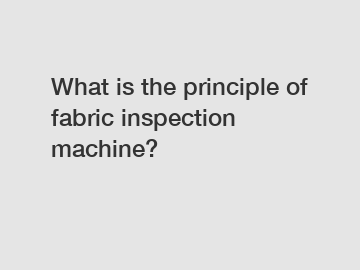What is the principle of fabric inspection machine?
What is the principle of fabric inspection machine?
Fabric inspection machines play a crucial role in the textile industry by ensuring that the fabric meets the desired quality standards before it is released for further processing. With the advancements in technology, these machines have become an integral part of the fabric manufacturing process. But what exactly is the principle behind fabric inspection machines? Let's delve into it.
1. Definition and Purpose:

Fabric inspection machines are automated systems that examine rolls of fabric and detect any defects or irregularities. Their primary purpose is to inspect the fabric for issues such as holes, stains, color variations, or flaws in the weaving. By identifying these imperfections, manufacturers can take the necessary steps to rectify or discard the faulty fabric, ultimately aiming for a higher standard of quality.
2. Inspection Mechanism:
The principle of fabric inspection machines lies in their inspection mechanism. These machines employ various techniques to scrutinize the fabric thoroughly. One of the common approaches is the predetermined path method, wherein the fabric is passed over a light panel. As the fabric moves across the panel, any variations in color or texture become visible, allowing operators to spot defects easily.
3. Sensor Technology:
Advanced fabric inspection machines utilize sensor technology to enhance the accuracy and efficiency of the inspection process. These sensors can detect and measure important parameters such as fabric width, tension, and color consistency. By continuously monitoring these factors, the machines can identify even the slightest deviation from the set standards.
4. Roll-to-Roll Inspection:
Fabric inspection machines are equipped to inspect fabric in continuous rolls, also known as roll-to-roll inspection. This capability allows for a seamless and uninterrupted evaluation of the fabric, ensuring that the entire length is thoroughly examined. The automated nature of these machines significantly reduces the time and effort required for inspection, improving overall productivity.
5. Data Analysis and Reporting:
Another fundamental aspect of fabric inspection machines is their ability to analyze and report data. These machines generate detailed reports that provide insights into the fabric's quality, defects, and other relevant parameters. This information can be used by manufacturers to identify problem areas and take corrective actions, ultimately leading to improved quality control.
6. Integration with Manufacturing Process:
Fabric inspection machines can be seamlessly integrated into the fabric manufacturing process, contributing to a more streamlined workflow. By placing the machine after the weaving or printing stage, fabric makers can identify and address defects before further processing. This integration helps in preventing the production of faulty finished goods, reducing wastage, and increasing customer satisfaction.
7. Human Intervention:
While fabric inspection machines automate the inspection process, human intervention is still crucial. Trained operators are responsible for setting the parameters, monitoring the inspection, and interpreting the results accurately. Their expertise ensures that any deviations from quality standards are duly recognized, and appropriate actions are taken.
8. Advantages and Limitations:
The principle of fabric inspection machines presents several advantages. Firstly, it enhances the overall quality of the fabric and prevents the shipment of defective products. Secondly, it minimizes the need for manual inspection, which can be time-consuming and prone to errors. However, it is essential to acknowledge the limitations of these machines. They may not detect very subtle defects or certain types of flaws that require tactile examination, such as softness or drape.
In conclusion, fabric inspection machines play a vital role in upholding quality standards in the textile industry. By employing various inspection mechanisms, utilizing sensor technology, and integrating seamlessly with the manufacturing process, these machines ensure that only defect-free fabric reaches the market. Although human intervention is crucial, the automated nature of these machines significantly enhances efficiency and productivity. Embracing the principle of fabric inspection machines enables textile manufacturers to offer superior products and maintain a competitive edge in the industry.
If you want to learn more, please visit our website Platen Foil Embossing Machine, High Productivity Die Cutting Machine, Foil Stamping Machine For Sale.

Comments
0